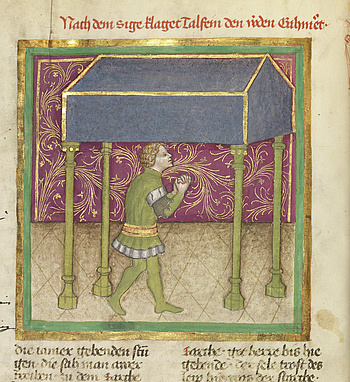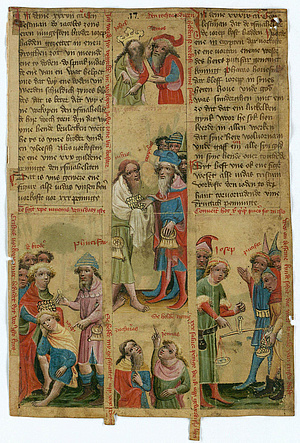Interdisciplinary Text-Image-Research on the German-Language Middle Ages
The Katalog der deutschsprachigen illustrierten Handschriften des Mittelalters, KdiH, (Catalogue of German-Language Illustrated Medieval Manuscripts) provides a basis for the text-image-research in the German lands. It focuses on the specific interplay and multi-facetted interdependencies of text and image. Art historians and textual scholars of German vernacular texts work hand in hand, creating a unique interface in manuscript science. This interface brings together in its analysis various different aspects of literary and cultural studies as well as art history. By documenting and describing these manuscripts, the KdiH has created a tool for medievalists of all disciplines, including historians, theologians, medical and legal scholars as well as literary scholars and codicologists.
Katalog der deutschsprachigen illustrierten Handschriften des Mittelalters (KdiH). Begonnen von Hella Frühmorgen-Voss und Norbert H. Ott. Hrsg. von Ulrike Bodemann, Kristina Freienhagen-Baumgardt, Pia Rudolph, Peter Schmidt, Christine Stöllinger-Löser und Nicola Zotz. Bd. 1ff. München 1991ff.

Zuletzt erschienen
Band 11, Lieferung 4–5 (120. Speculum humanae salvationis – 130. Trojanerkrieg)
During the Middle Ages books were initially produced in order to preserve and circulate texts. Very soon these texts came to be supplemented by additional elements: Book decoration was added to the manuscripts. From around the middle of the 12th century, images were provided alongside the texts in the German-language codices. During the 14th and the 15th century a large number of illustrated manuscripts are to be found: Colorful initials, for example, can include an author portrait or tell a brief story. Some texts have just an opening historiated initial, while others are enhanced with veritable iconographic programs, there are jotted sketches as well as prestigious illuminations, some of them using gold and other precious material.
Unique Interface in Manuscript Research
Illustrated manuscripts contributed significantly to creating and advancing a medieval society’s cultural identity. Regardless of their origin in a monastery, for the court or, as more often in the later Middle Ages, in a workshop in the city – they always serve as indicators of the social conditions of their origins and the significance of their contents. An affluent patron wants to demonstrate his wealth with a richly illuminated bible, a nun documents the significance of her faith in an illustrated prayer book, or illustrated functional texts give instructions to the reader: Text and image generally interrelate rather closely, also conveying to today’s readers an impression of the medieval world.
Funding

The KdiH is funded by the Federal Republic of Germany and the Free State of Bavaria as part of the Academies' Programme.
In recent years a number of additional institutions have supported work on the catalogue with generous external funding:
- Bayerische Forschungsstiftung
- Deutsche Forschungsgemeinschaft (DFG)
- Gesellschaft der Freunde der Bayerischen Akademie der Wissenschaften / Stiftung zur Förderung der Wissenschaften
- The Getty Foundation
- Alfried Krupp von Bohlen und Halbach-Stiftung
- Heribert Tenschert Antiquariat Bibermühle
- Karl Thiemig Stiftung
- Fritz Thyssen Stiftung

